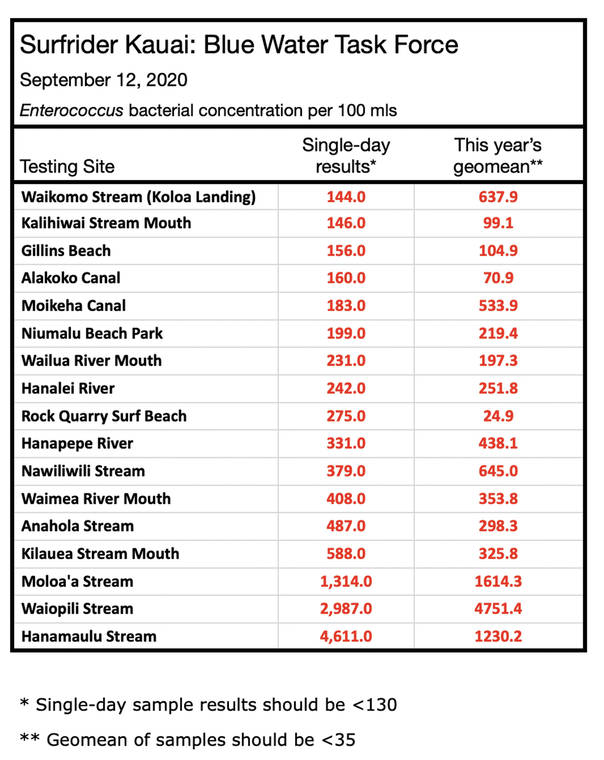LIHU‘E — The Kaua‘i Chapter of Surfrider’s Blue Water Task Force has completed water quality sampling for September 2020, with a limited set of data due to the pandemic. The task force isn’t using volunteers to collect samples during the COVID-19 pandemic and samples are being taken by Surfrider member and Blue Water Task Force coordinator John Alderete, and senior scientist Carl Berg.
LIHU‘E — The Kaua‘i Chapter of Surfrider’s Blue Water Task Force has completed water quality sampling for September 2020, with a limited set of data due to the pandemic. The task force isn’t using volunteers to collect samples during the COVID-19 pandemic and samples are being taken by Surfrider member and Blue Water Task Force coordinator John Alderete, and senior scientist Carl Berg.
The values in red on the graph of sampling results exceed Hawai‘i state standards of 130 organisms per 100 ml for a single sample and 35 organisms per 100 ml for a geometric mean of 5 or more samples.
Typically, our surf and beach sites are mostly clean; for September, all sites tested above the desired bacterial counts. Wailua Beach Park was not tested this month due to construction and site unavailability
Most sites at or near rivers, streams, or canals, showed high bacterial counts. Moloa’a, Waiopili, and Hanamaulu Streams tested well above 1000 bacterial organisms per 100 mls of tested sample: 1,314, 2,987, and 4,611, respectively.
“We always recommended that sites consistently above the statistical threshold value should be posted with caution signs. Sites where the geometric mean are in the thousands are badly polluted with fecal indicating bacteria,” Alderete said in a discussion of the September results. “As well, when it rains, be aware of Brown Water Advisories from Hawaii Department of Health. In addition to increased pollution, brown water also has a potential increase of issues with sharks.”

Subscribe today for unlimited access.
Already a subscriber?
Login
Not ready to subscribe?
Register for limited access.
If you have a print subscription but require digital access,
activate your account.





Why is Hanamaulu always so bad. Is that a single source for pollution there.?
obviously it’s not the cemeteries up mauka!